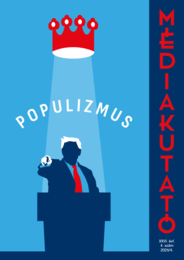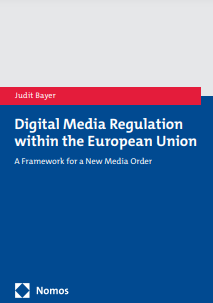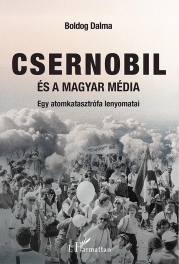Médiakutató
The media studies quarterly Médiakutató (The Media Researcher), established in 2000 and published by the Media Research Foundation, a not-for-profit organisation based in Budapest and registered in Hungary, is a double-blind peer-reviewed journal, anonymity being provided for both authors and reviewers, and the suitability of manuscripts being determined by at least two reviewers.The Media Researcher is a member of the Central and Eastern European Network of Media Journals and is listed is as a “Category A” journal by the Hungarian Academy of Sciences. Its editorial board is assisted by an international advisory board.
>> Archive
Contents – Winter 2025
Szöllőskei, Levente:
Szöllőskei, Levente:
Race-Based Populism in Donald Trump’s Online Political Discourse
It is impossible to effectively interpret the political world of our time without meticulously analysing the communication strategies of political leaders. This paper maps the characteristics of US President Donald Trump’s populist political communication based on an online discourse on a civil movement that took a stand against racial discrimination. The corpus, created between 2017 and 2020 and aimed at undermining the movement, consists of Donald Trump’s Twitter posts submitted to critical discourse analysis. This paper argues that the President used the fundamental tools of populist political communication even in his politically charged Twitter posts, as his aim was to dominate the political agenda and to ignore the unresolved issues of race in the US.
Keywords: discourse analysis, Donald Trump, political communication, populism, twitter
Race-Based Populism in Donald Trump’s Online Political Discourse
Médiakutató Winter 2025 pp. 9-21 https://doi.org/10.55395/MK.2025.4.1
Paár, Ádám:
Paár, Ádám:
Two Periods of Populism in the USA
The populist movement, founded in the end of the 19th century in the USA, was a project based on writers. The movement, and the People’s Party (or Populist Party) based on it, promoted many progressive ideas, including progressive taxation, eight-hour workdays, women’s suffrage, and the protection of farmers and industrial workers, based on labour and farmer movement ideas. Politically, however, it was a failure, and the party was dissolved in 1908. Owing to the Great Depression, populism was reborn in the 1930s, and several self-appointed politicians came to voice old Populist slogans and phrases. The most famous of them, Governor of Louisiana Huey P. Long, served as a model for Governor Willie Stark, the protagonist of All the King’s Men, a novel by Robert Penn Warren. This paper presents the US populist movement based on two novels.
Keywords: capitalism, farmer, populism, the United States, utopia
Two Periods of Populism in the USA
Médiakutató Winter 2025 pp. 23-30 https://doi.org/10.55395/MK.2025.4.2
Rudisch, Ferenc:
Rudisch, Ferenc:
The Institutionalisation of Journalism Education and Press Studies in Hungary from the Late 19th Century to the 1930s
This paper examines the key milestones in the institutionalisation of journalism education and journalism studies in Hungary from the late 19th century to the mid-1930s. The main argument of the paper is that the interconnected institutionalisation of the two fields was delayed not only by the occasional resistance of the journalistic community, but primarily by the most significant turning points in Hungary’s political and economic history (such as the consequences of the world wars and the Great Depression) – despite the fact that institutionalisation initiatives generally emerged in parallel with international developments. Beyond organising the processes into a coherent narrative, the study seeks to complement earlier research by reconstructing the experiment of László Tápay-Szabó in Szeged and provides a detailed account of the biography of this journalist-turned-university lecturer. In a broader context, the paper aims to contribute to the self-reflective discourse of media studies in Hungary by highlighting the field’s historical antecedents.
Keywords: institutionalisation, journalism education, journalism studies, press research, professionalisation
Médiakutató Winter 2025 pp. 33-43 https://doi.org/10.55395/MK.2025.4.3
Koloh, Gábor:
Koloh, Gábor:
The Theory and Practice of Pronatalism: The Story of an Abortionist Doctor
In the interwar period, Hungarian society underwent a major structural transformation: although the population was growing, owing to the arrival of refugees after the Trianon Treaty, internal migration and, above all, the decline in birth rate led to a profound demographic debate about the future of the country and its people. The governments of the Horthy Era pursued a pronatalist policy which involved the overt acceptance of revisionist demands. The social practice of birth control was openly criticised, and the press regularly reported on the trials of women who had had abortions and the midwives and doctors who had assisted and induced them. One such case was the trial of Imre Kincses, a doctor in Vésztő (Békés County), whose actions were depicted in dark coulours by the press as the trial progressed. However, Kincses, who was sentenced to one year in prison, did everything in his power to secure his release and his plea for pardon submitted to Regent Miklós Horthy was acknowledged. This paper examines the background and media coverage of the case by analysing relevant press articles and trial material.
Keywords: birth control, presidential pardon, press representation, pronatalist politics
The Theory and Practice of Pronatalism: The Story of an Abortionist Doctor
Médiakutató Winter 2025 pp. 45-56 https://doi.org/10.55395/MK.2025.4.4
Hegedüs, Márk – Szegedi, Péter – Bodor, Ákos:
Hegedüs, Márk – Szegedi, Péter – Bodor, Ákos:
Scandinavian Hell
In this study, we systematically analyse the representation of Sweden in the Hungarian media based on a qualitative analysis of written content published in Hungarian online media over the past five years. Our findings suggest that the media coverage of Sweden in the Hungarian media is dominated by a strong and dynamic negative narrative, portraying the Scandinavian country as a fragmented and unliveable society. This interpretation is predominantly represented in public media and pro-government media outlets. Media supported by opposition parties convey a much weaker but contrasting narrative, also presented in a simplified manner. Hence, truly complex information is provided only by independent outlets. Regarding the overall operation of the media, it is safe to suggest that topics are dictated by pro-government outlets, with narrative construction always starting with them, while other news organisation merely respond to this in various ways.
Keywords: Hungary, media analysis, political polarization, Sweden
Médiakutató Winter 2025 pp. 59-73 https://doi.org/10.55395/MK.2025.4.5
Somlyai, Özge:
Somlyai, Özge:
The Changing Scope and Role of Alternative Media in Countering Authoritarian Narratives in Turkey
This article examines how fear has been institutionalised in Turkey’s media environment under the Justice and Development Party (AKP) headed by Recep Tayyip Erdoğan and how alternative news outlets, created and managed by professional journalists and including Bianet, Medyascope, and T24, exhibited resilience in countering the regime’s authoritarian narratives. It also explores AKP’s systematic efforts to transform mainstream media into propaganda tools through legal, economic, and regulatory measures. Relying on semi-structured interviews conducted with journalists from these news outlets, media scholars, and political scientists, it studies the evolving scope of alternative news media in Turkey. While Medyascope and T24 now view themselves as pioneering actors creating and shaping space for ‘new mainstream media,’ Bianet remains an important representative of alternative media in the country. By embracing digital platforms, fostering investigative practices, and amplifying voices unheard or suppressed, these outlets challenge the AKP Government’s fear-driven narratives and create space for democratic dialogue. Thus, this study contributes to broader debates on the role of media and more specifically on the role of professional journalists in sustaining (counter-)public spaces in authoritarian contexts by emphasising the resilience of journalists and the evolving nature of alternative media in Turkey.
Keywords: alternative, journalism, mainstream, media, Turkey
The Changing Scope and Role of Alternative Media in Countering Authoritarian Narratives in Turkey
Médiakutató Winter 2025 pp. 77-89 https://doi.org/10.55395/MK.2025.4.6




